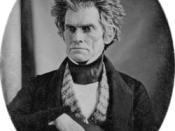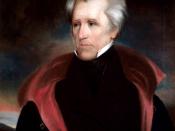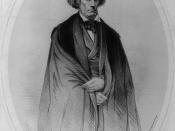It has been rare in American history for presidents and vice-presidents not to get along, but it has happened on a few occasions: Adams and Jefferson, Kennedy and Johnson, and Eisenhower and Nixon are a few examples (Jackson vs. Calhoun-Part 1 1). However, the most controversial relationship between president and his assistant was between Andrew Jackson and John C. Calhoun. Their disagreements began very early on in Jackson's administration, and lasted until after the resolution of the Nullification Crisis. Nullification is the refusal of a state to recognize a federal law within its boundaries and deem that law unconstitutional. In this case, South Carolina, led by John C. Calhoun, refused to recognize the protective tariffs in 1828, and 1832, saying that they benefited the North and injured the South. At this point in time, the American system of government was fairly new and the struggle between state and federal power was in full swing.
Towards the end of the crisis, Calhoun went so far as to threaten to secede from the Union to show Jackson and the rest of America that individual state governments were indeed powerful. When the quarrel had reached its peak, Jackson had had enough and decided it was time to put an end to the crisis. The actions and decisions made by President Andrew Jackson in regards to John C. Calhoun and the Nullification Crisis not only enabled the Union to remain together, but proved the power of the federal government.
Before reviewing Jackson's actions during the Nullification Crisis it is important to understand where the disagreements between the two men originated. In 1829, just shortly before Jackson was inaugurated, John Eaton, a friend and soon to be secretary of war under Jackson, married the widow and non-reputable Peggy O'Neale Timberlake. Because Timberlake was...


